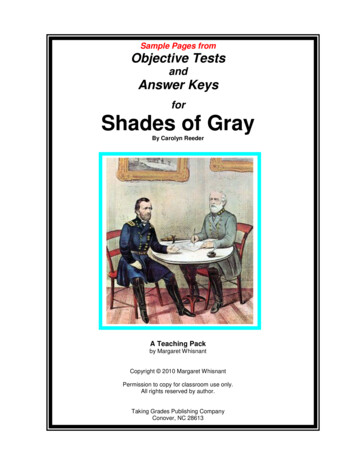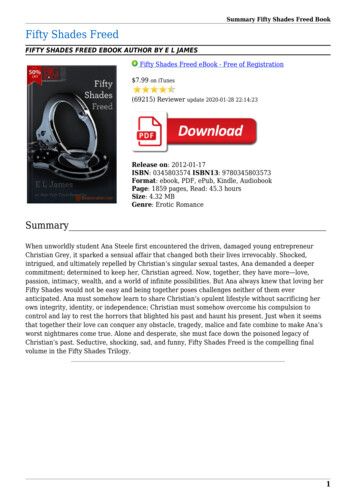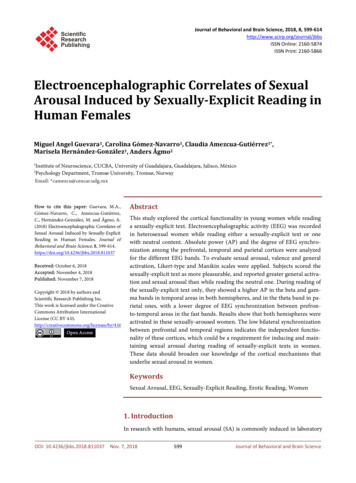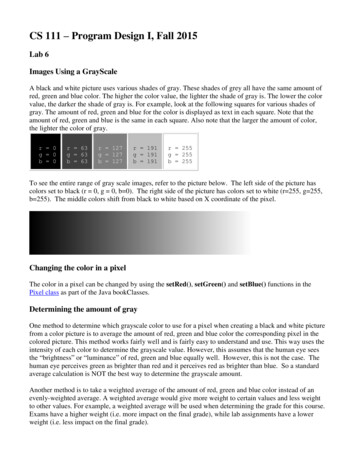
Transcription
Sample Pages fromObjective TestsandAnswer KeysforShades of GrayBy Carolyn ReederA Teaching Packby Margaret WhisnantCopyright 2010 Margaret WhisnantPermission to copy for classroom use only.All rights reserved by author.Taking Grades Publishing CompanyConover, NC 28613
Table of ContentsObjective TestsChapter TestsPageChapter 1 . . . . . . . . . . . . . . . . . . . . . . . . . . . . . . . . . . . . . . . . . . . . . . . . . . . . . . . . . .1-2Chapter 2 . . . . . . . . . . . . . . . . . . . . . . . . . . . . . . . . . . . . . . . . . . . . . . . . . . . . . . . . . 3-4Chapter 3. . . . . . . . . . . . . . . . . . . . . . . . . . . . . . . . . . . . . . . . . . . . . . . . . . . . . . . . . . 5-6Chapter 4 . . . . . . . . . . . . . . . . . . . . . . . . . . . . . . . . . . . . . . . . . . . . . . . . . . . . . . . . . . .6Chapter 5. . . . . . . . . . . . . . . . . . . . . . . . . . . . . . . . . . . . . . . . . . . . . . . . . . . . . . . . . . . 7Chapter 6 . . . . . . . . . . . . . . . . . . . . . . . . . . . . . . . . . . . . . . . . . . . . . . . . . . . . . . . . . .8-9Chapter 7 . . . . . . . . . . . . . . . . . . . . . . . . . . . . . . . . . . . . . . . . . . . . . . . . . . . . . . . .10-11Chapter 8 . . . . . . . . . . . . . . . . . . . . . . . . . . . . . . . . . . . . . . . . . . . . . . . . . . . . . . . . . . 12Chapter 9 . . . . . . . . . . . . . . . . . . . . . . . . . . . . . . . . . . . . . . . . . . . . . . . . . . . . . . . . . .13Chapter 10. . . . . . . . . . . . . . . . . . . . . . . . . . . . . . . . . . . . . . . . . . . . . . . . . . . . . . .14-15Chapter 11 . . . . . . . . . . . . . . . . . . . . . . . . . . . . . . . . . . . . . . . . . . . . . . . . . . . . . . . . . 16Chapter 12. . . . . . . . . . . . . . . . . . . . . . . . . . . . . . . . . . . . . . . . . . . . . . . . . . . . . . . . . 17Chapter 13 . . . . . . . . . . . . . . . . . . . . . . . . . . . . . . . . . . . . . . . . . . . . . . . . . . . . . . 18-19Chapter 14. . . . . . . . . . . . . . . . . . . . . . . . . . . . . . . . . . . . . . . . . . . . . . . . . . . . . . . . . 20Chapter 15 . . . . . . . . . . . . . . . . . . . . . . . . . . . . . . . . . . . . . . . . . . . . . . . . . . . . . . . . . 21Chapter 16 . . . . . . . . . . . . . . . . . . . . . . . . . . . . . . . . . . . . . . . . . . . . . . . . . . . . . . 22-23Chapter 17 . . . . . . . . . . . . . . . . . . . . . . . . . . . . . . . . . . . . . . . . . . . . . . . . . . . . . . . . 24Whole Book Test . . . . . . . . . . . . . . . . . . . . . . . . . . . . . . . . . . . . . . . . . . . . . 25-27Answer Keys . . . . . . . . . . . . . . . . . . . . . . . . . . . . . . . . . . . . . . . . . . . . . . . . . .28-29About Your Teaching Pack . . . . . . . . . . . . . . . . . . . . . . . . . . . . . . . . 30-32
SHADES OF GRAYBy Carolyn ReederChapter 1Pages 1-14Write the letter of the correct answer in the blank before each question.1.This story takes place (A) just before the Civil War, (B) during theCivil War, (C) just after the Civil War.2.Willie had to go live with his aunt because (A) his mother had requested it,(B) he had inherited some nearby land, (C) his only sister was there.3.Where did Will’s aunt live? (A) the Shenandoah Valley, (B) the VirginiaPiedmont, (C) Kentucky.4.What happened to Will’s family? (A) They were missing. (B) They died inthe war. (C) They escaped to the North and disappeared.5.Will did not like his uncle because (A) he considered him a traitor and acoward, (B) he was a cruel man, (C) he made fun of Will’s appearance.6.Which side did Will’s family fight for during the war? (A) neither one, (B) theNorth, (C) the South.7.Will was (A) nine years old, (B) twelve years old, (C) eighteen years old.8.The girl Will had seen on the way to his aunt’s farm was (A) a neighbor,(B) his sister, (C) his cousin.9.When Will first saw his aunt, she (A) reminded him of his mother, (B) huggedhim, (C) looked worried.10.Will’s little sisters (A) went south to live with an uncle, (B) disappeared undermysterious circumstances, (C) died of typhoid fever.11.Doc Martin (A) was a friend of Will’s father, (B) had taken care of Will’s motherduring her long illness, (C) couldn’t afford to take care of Will.12.What happened to Meg’s horse? (A) The Yankees took it. (B) The Rebelstook it. (C) It died of starvation.Copyright 2008 Margaret WhisnantTaking Grades Publishing Company, Conover, NC 286131
SHADES OF GRAYBy Carolyn ReederChapter 2Pages 15-25Write either True or False in the blank before each statement.1. Will remembered how he used to wash his face every morning in hotwater brought to him by a slave.2. Uncle Jed got up early to feed what little stock the family had left.3. During the war, both Yankees and Rebels had stolen from Uncle Jedand his family.4. Uncle Jed and his family lived in Kentucky.5. Aunt Ella saved a few sacks of buckwheat from the Yankees bymaking them look like bed pillows.6. Uncle Jed took Will with him to check the trap line because he wantedWill to take over the job.7. Will was determined to keep up with his Uncle Jed and show him thata town boy could get along in the country.8. Uncle Jed hoped to catch beavers in the traps.9. Uncle Jed told Will to drink all the water he wanted because they hada long way to go.10. Will was able to find his way back home along the trap line withouta single mistake.11. Will refused to say the name “Uncle Jed.”12. Will discovered it was his father who had prevented his mother fromwriting to Aunt Ella during the war.Copyright 2008 Margaret WhisnantTaking Grades Publishing Company, Conover, NC 286132
SHADES OF GRAYBy Carolyn ReederChapter 3 Pages 25-34Write the letter of the correct answer in the blank before each question.1.Meg made Will feel ashamed by saying she (A) hated him for leavingher alone in the garden, (B) bet he didn’t know how to fish, (C) would rather sitin the shade than work in the garden.2.Which of the following did not happen to one of Will’s family slaves?(A) Fred got a job in a livery stable. (B) Lizzy died of typhoid. (C) Calliewas hired as a cook.3.What started the argument about what the Rebels had done to Meg’s familyand what the Yankees had done to Will’s family? (A) Will wondered whatit was like in Ohio. (B) Meg said the blackberries wouldn’t be any goodwithout cream. (C) Meg refused to listen to Will’s stories about his family.4.Will didn’t know how to answer when Meg said (A) his sisters could havedied even if there hadn’t been a war, (B) her pa didn’t fight for a cause hedidn’t believe in, (C) Will’s father had been wrong to join in the fight.5.Will’s brother Charlie had been killed by a Yankee even though he (A) was onlyfourteen years old, (B) was not a soldier, (C) was not carrying a weapon.6.When Meg started asking about Charlie, Will (A) became really angry anddidn’t want to talk about it, (B) almost cried, (C) calmly told her the story of howCharlie died.7.How did Will know the three boys who came toward Meg and him weren’tin a friendly mood? They (A) carried weapons, (B) looked mad, (C) had aswaggering walk.8.Will avoided being pushed in the pond by (A) punching Hank in the nose,(B) agreeing to give up the fish he caught, (C) pretending that he would liketo go for a swim.9.The three boys behaved (A) like bullies, (B) as though they wanted to befriends, (C) as if they were a bit afraid of Will.10.Will handled Hank, Patrick, and Amos by (A) acting as if he weren’t afraidof them, (B) giving them what they wanted, (C) running from them.Copyright 2008 Margaret WhisnantTaking Grades Publishing Company, Conover, NC 286133
SHADES OF GRAYBy Carolyn ReederWHOLE BOOK TESTWrite the letter of the correct answer in the blank before each question.1.This story took place just after (A) the Revolutionary War, (B) the Civil War,(C) the Mexican-American War.2.Where did this story take place? (A) Pennsylvania, (B) Ohio, (C) Virginia.3.How did William’s father die? (A) He was killed in battle. (B) He hadtyphoid fever. (C) He died in a Yankee prison.4.What happened to Will’s sisters? (A) They died of typhoid fever. (B) Theydied in a Yankee prison. (C) They starved to death.5.Will’s older brother Charlie (A) had disappeared, (B) was killed in battle,(C) tried to play a joke and was shot by a Yankee.6.Will’s mother (A) was shot by Yankees, (B) died of a disease and a brokenheart, (C) killed herself.7.How old was Will? (A) ten, (B) sixteen, (C) twelve.8.Why did Will go to live with Uncle Jed and Aunt Ella? (A) They were hisonly relatives. (B) Uncle Jed had sent for him. (C) His mother had writtenthat she wanted him to.9.Will thought his Uncle Jed was a coward and a traitor because (A) he wasa southerner and he refused to fight in the war, (B) he helped supply theYankees with food, (C) he moved his family north during the war.10.When they were little girls, Aunt Ella and Will’s mother were (A) raised inrich surroundings, (B) separated and sent to live with different families,(C) both raised in poverty.Copyright 2008 Margaret WhisnantTaking Grades Publishing Company, Conover, NC 286134
About Your Teaching Pack . . .The primary goal in creating the teaching packs for children’s novels is to provide a classroom-ready,non-threatening method for checking student comprehension and stretching thinking skills. When used as abasic guide for teaching a novel, the materials offer many and varied opportunities for learning.Use your teaching pack as a guide and lead your students into discovering new ideas about . . . . .THE PLOTEach test page is actually an outline of the plot. In your teaching pack, the chain of related events that tellthe story has been pulled from the novel and reformatted into a series of questions. Whether they are awareof their ability or not, all good readers sense the rhythm of the connected events that compose the plot; andconsequently comprehend the story. This “plot rhythm” is the basic structure of the tests.To further your students’ understanding of plot, try the following activities:Summarizing the Story: Using only the chapter questions as a guide, have your students write a summaryof the chapter. For a set of ten questions, limit the number of sentences they may write to seven. For twentyquestions, allow no more than twelve sentences.Reporting the News: Have students write a newspaper article, based on the events from a set of questions,and add the who, what, when, where, why format. Some needed information may be located in previouschapters.Twisting the Plot: Choose one or two questions from each chapter and change its answer—true to false, noto yes, or a different answer—and explain how changing a single (or several) events would change the story.To further illustrate the rhythm of a good story, try changing the answers to one complete set of questions.Your students will see how difficult, if not impossible, it is to tell a sensible story from a tangled set of events.THE CHARACTERSQuestions that illustrate character motivation and personality are purposely included. Too often, whenthey are asked to tell what kind of person a story character is, the only answer many of our students canmuster is “nice.”In your efforts to remove “nice” from your students’ literary vocabulary, try this idea:Character Charts: Display individual charts for the main characters. As the chapters are read, record facts,behaviors, or events that relate to the each character. Then connect the items with several appropriatewords such as empathetic, brave, calloused, bold, untrustworthy, etc. The teacher can take the lead bycontributing the first few words and then assigning the task of identifying more terms to students. Record theword collections on the charts with the story facts.This information is a valuable student resource when displayed in the room for all to see and use during awriting assignment. In creating and using character charts, students will soon begin writing more fluently andinsightfully about story personalities.Use the charts to encourage your students to try some “predicting” or “detective” writing about what thecharacter(s) might do next or what might have happened after the story ended. Let the charts help yourstudents recognize CHARACTER CHANGE (dynamics).Another fun activity with the charts is to match a book personality with a zodiac sign. Students mustjustify their reason for thinking a character is a particular sign by citing his/her behaviors, words, reactions tosituations, etc. that prove the match.READING BETWEEN THE LINES(Implied Meaning)Because the primary goal for the objective questions is basic comprehension, items requiring a studentto interpret an event or a character’s behavior are not included. Always included, however, are questions thatestablish the existence of a story component carrying an implied meaning.Copyright 2008 Margaret WhisnantTaking Grades Publishing Company, Conover, NC 286135
MAKING PREDICTIONS(Recognizing Story Clues)Authors subtly place clues in the story line giving the reader hints as to what is about to happen. Like theimplied meaning, these clues are brought to the reader’s attention in the form of a question. Once a studentlearns to spot the gems, his/her ability to comprehend and enjoy a story tends to leap forward.Use “thinking-out-loud” class discussions to list all the possible meanings of the clue questions. Have yourstudent write their individual predictions (no sharing or telling), store the papers until the novel is finished, andthen retrieve them for reading. Sometimes, a wrong prediction makes a story as good as the original.OTHER FUCTIONSThe objective test pages are excellent discussion guides for both whole groups and small groups. Theywork well as homework reading guides and as conferencing tools. They are also useful management toolsfor teachers who wish to use multiple titles in one classroom.IMPROVING/DEVELOPING LISTENING SKILLSRather than always requiring your students to answer test questions on a printed page, surprise them (andsave paper!!) by occasionally doing the test orally.Try this technique:Student Rules for an Oral Test:The teacher will read each question two times. No comments or questions that interrupt this initial phase ofthe test are allowed.When all questions have been read, individual students may ask for repeats of anyquestion he/she wishes to hear again.No interruptions/comments during the re-reading part of the test.Teacher Rules for an Oral Test:The teacher will read each question two times. Except to remind students that are-reading phase will following after the last question, he/she will not respond tocomment/question during this period.The teacher will repeat any and all questions (even if it results in reading the samequestion multiple times).(The second teacher rule is a vital part of the exercise. Asking for multiple repeats of a question does notmean students aren’t paying attention. It does indicate their desire to understand and answer the questioncorrectly.)As students become more comfortable and experienced with oral test-taking, the number of requests forrepeated questions will diminish. An added bonus to this technique is that skills learned in these testingperiods tend to translate into other situations where teacher-talking and student-listening are requiredcomponents of learning.Final NoteThe Novel Teaching Packs are designed for use as supplementary material that supports a total readingprogram. It is my goal to provide busy teachers with a classroom-ready, practical resource loaded withmotivational and learning opportunities for their students. It is my hope that your purchase will prove to be ahard-working instructional component for years to come. Thanks for choosing one of my products for yourclassroom.Margaret Whisnant, AuthorCopyright 2008 Margaret WhisnantTaking Grades Publishing Company, Conover, NC 286136
SHADES OF GRAY By Carolyn Reeder Chapter 2 Pages 15-25 Write either True or False in the blank before each statement. _1. Will remembered how he used to wash his face every morning in hot water brought to him by a slave. _2. Uncle Jed got up early to feed what little stock the family had left. _3.










